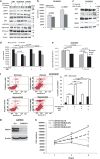Hypoxia-induced oxidative stress promotes MUC4 degradation via autophagy to enhance pancreatic cancer cells survival
- PMID: 27109098
- PMCID: PMC5079846
- DOI: 10.1038/onc.2016.119
Hypoxia-induced oxidative stress promotes MUC4 degradation via autophagy to enhance pancreatic cancer cells survival
Abstract
Pancreatic cancer (PC) and associated pre-neoplastic lesions have been reported to be hypoxic, primarily due to hypovascular nature of PC. Though the presence of hypoxia under cancerous condition has been associated with the overexpression of oncogenic proteins (MUC1), multiple emerging reports have also indicated the growth inhibitory effects of hypoxia. In spite of being recognized as the top-most differentially expressed and established oncogenic protein in PC, MUC4 regulation in terms of micro-environmental stress has not been determined. Herein, for the first time, we are reporting that MUC4 protein stability is drastically affected in PC, under hypoxic condition in a hypoxia inducible factor 1α (HIF-1α)-independent manner. Mechanistically, we have demonstrated that hypoxia-mediated induction of reactive oxygen species (ROS) promotes autophagy by inhibiting pAkt/mTORC1 pathway, one of the central regulators of autophagy. Immunohistofluorescence analyses revealed significant negative correlation (P-value=0.017) between 8-hydroxy guanosine (8-OHG) and MUC4 in primary pancreatic tumors (n=25). Moreover, we found pronounced colocalization between MUC4 and LAMP1/LC3 (microtubule-associated protein 1A/1B-light chain 3) in PC tissues and also observed their negative relationship in their expression pattern, suggesting that areas with high autophagy rate had less MUC4 expression. We also found that hypoxia and ROS have negative impact on overall cell growth and viability, which was partially, though significantly (P<0.05), rescued in the presence of MUC4. Altogether, hypoxia-mediated oxidative stress induces autophagy in PC, leading to the MUC4 degradation to enhance survival, possibly by offering required metabolites to stressed cells.
Conflict of interest statement
The authors declare no conflict of interest.
Figures







Similar articles
-
NCOA3-mediated upregulation of mucin expression via transcriptional and post-translational changes during the development of pancreatic cancer.Oncogene. 2015 Sep 10;34(37):4879-89. doi: 10.1038/onc.2014.409. Epub 2014 Dec 22. Oncogene. 2015. PMID: 25531332 Free PMC article.
-
Insulin-like growth factor 1 receptor-mediated cell survival in hypoxia depends on the promotion of autophagy via suppression of the PI3K/Akt/mTOR signaling pathway.Mol Med Rep. 2017 Apr;15(4):2136-2142. doi: 10.3892/mmr.2017.6265. Epub 2017 Mar 1. Mol Med Rep. 2017. PMID: 28260056 Free PMC article.
-
Nicotine/cigarette smoke promotes metastasis of pancreatic cancer through α7nAChR-mediated MUC4 upregulation.Oncogene. 2013 Mar 14;32(11):1384-95. doi: 10.1038/onc.2012.163. Epub 2012 May 21. Oncogene. 2013. PMID: 22614008 Free PMC article.
-
MUC4 mucin- a therapeutic target for pancreatic ductal adenocarcinoma.Expert Opin Ther Targets. 2017 Jul;21(7):657-669. doi: 10.1080/14728222.2017.1323880. Epub 2017 May 29. Expert Opin Ther Targets. 2017. PMID: 28460571 Free PMC article. Review.
-
MUCIN-4 (MUC4) is a novel tumor antigen in pancreatic cancer immunotherapy.Semin Immunol. 2020 Feb;47:101391. doi: 10.1016/j.smim.2020.101391. Epub 2020 Jan 14. Semin Immunol. 2020. PMID: 31952903 Free PMC article. Review.
Cited by
-
Study of oxygen tension variation within live tumor spheroids using microfluidic devices and multi-photon laser scanning microscopy.RSC Adv. 2018 Aug 28;8(53):30320-30329. doi: 10.1039/c8ra05505j. eCollection 2018 Aug 24. RSC Adv. 2018. PMID: 35546825 Free PMC article.
-
Locoregional Therapies and Remodeling of Tumor Microenvironment in Pancreatic Cancer.Int J Mol Sci. 2023 Aug 11;24(16):12681. doi: 10.3390/ijms241612681. Int J Mol Sci. 2023. PMID: 37628865 Free PMC article. Review.
-
Aptamer-PEG-modified Fe3O4@Mn as a novel T1- and T2- dual-model MRI contrast agent targeting hypoxia-induced cancer stem cells.Sci Rep. 2016 Dec 15;6:39245. doi: 10.1038/srep39245. Sci Rep. 2016. PMID: 27976736 Free PMC article.
-
Targeting hypoxic tumor microenvironment in pancreatic cancer.J Hematol Oncol. 2021 Jan 13;14(1):14. doi: 10.1186/s13045-020-01030-w. J Hematol Oncol. 2021. PMID: 33436044 Free PMC article. Review.
-
Proteogenomics of non-small cell lung cancer reveals molecular subtypes associated with specific therapeutic targets and immune evasion mechanisms.Nat Cancer. 2021 Nov;2(11):1224-1242. doi: 10.1038/s43018-021-00259-9. Epub 2021 Nov 22. Nat Cancer. 2021. PMID: 34870237 Free PMC article.
References
-
- Siegel R, Ma J, Zou Z, Jemal A. Cancer statistics, 2014. CA Cancer J Clin. 2014;64:9–29. - PubMed
-
- Sullivan R, Pare GC, Frederiksen LJ, Semenza GL, Graham CH. Hypoxia-induced resistance to anticancer drugs is associated with decreased senescence and requires hypoxia-inducible factor-1 activity. Mol Cancer Ther. 2008;7:1961–1973. - PubMed
-
- Graeber TG, Osmanian C, Jacks T, Housman DE, Koch CJ, Lowe SW, et al. Hypoxia-mediated selection of cells with diminished apoptotic potential in solid tumours. Nature. 1996;379:88–91. - PubMed
-
- Andrianifahanana M, Moniaux N, Schmied BM, Ringel J, Friess H, Hollingsworth MA, et al. Mucin (MUC) gene expression in human pancreatic adenocarcinoma and chronic pancreatitis: a potential role of MUC4 as a tumor marker of diagnostic significance. Clin Cancer Res. 2001;7:4033–4040. - PubMed
MeSH terms
Substances
Grants and funding
LinkOut - more resources
Full Text Sources
Other Literature Sources
Medical
Research Materials
Miscellaneous

